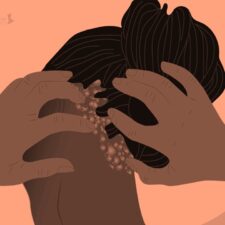
“Ooooh, she thick!” That’s usually a phrase that is used in a good way. Some men say they don’t want a woman who is too skinny, so being “thick” is in. But what is “too thick” when it comes to our health?
“Thick” and “obese” are not interchangeable terms. “Thick” is a subjective descriptor often used to describe someone with a larger build, particularly in their hips and thighs, and can be associated with a healthy amount of muscle and fat. “Obese”, on the other hand, is a medical term based on a person’s Body Mass Index (BMI) (a measure of body fat based on height and weight). A BMI of 30 or higher indicates obesity.
With the term “thick” rapidly being accepted as embracing a few extra pounds, fitness champion and author, Laticia “Action” Jackson cautions Black women to put aside the images portrayed to us in our homes, communities, as well as mass media and take control of their well-being. Recently, BlackDoctor.org had the opportunity to catch up with the 2008 Fitness Olympian, who stressed the urgency of making time for ourselves.
“One of the things I really try to encourage women is I don’t care if you only get 20 minutes – doing something for yourself each day is important,” said Jackson.
When asked about the inspiration behind her latest book Jackson replied: “I’ve been in this field for 16 years. As a professional athlete, I’m usually the only Black woman inside my circle and one thing I noticed is that while there’s an overabundance of health, fitness and nutrition books available for today’s consumer, the health and wellness market really wasn’t paying attention to African American women and the challenges we face when trying to shed extra pounds, proper nutrition, and fitness.”
As health fanatics know far too well, obesity has been linked to type 2 diabetes, heart disease, hypertension, stroke and many forms of cancer. “If you look at the health disparity of African American women, we are literally dying,” Jackson stressed. “The data is alarming. According to the CDC, 4 out of 5 African American women are obese. So, I just said you know what? I’m going to take the next six months and write a book that’s just for us.”
What is “Thick” and What Is Overweight? Understanding BMI
One of the most commonly used tools to define “healthy weight” is the Body Mass Index (BMI)—but did you know it was never designed for Black women or even non-white populations?
1. The Origins of BMI
The first thing to know about the BMI is that it was created by a Belgian mathematician — not a doctor or health practitioner.
In the 1830s, Lambert Adolphe Jacques Quetelet set out not to devise a test to quickly diagnose obesity (which was still years away from being widely perceived as a problem) but to find the “l’homme moyen” or the “average man.”
He thought you could take thousands of measurements, compare them, and find the ideal weight. He calculated these samples and found that weight typically increases concerning a person’s square height.
But Quetelet’s experiment had big limitations. For one, all the participants were Western European men. The experiment also had nothing to do with measuring individual health. Despite its outdated origins, doctors still use BMI today to diagnose obesity and health risks.
2. Why BMI Is Inaccurate for Black Women
Black women naturally have the following:
- More muscle mass than white women (muscle weighs more than fat, making BMI higher).
- Denser bones, meaning we might weigh more but not carry excess fat.
- Different fat distribution (Black women often store fat in the hips, thighs, and buttocks instead of the stomach, which is less harmful metabolically).
Studies have shown that Black women with a BMI in the “overweight” or “obese” range can still have perfectly normal blood pressure, cholesterol, and metabolic health—proving that BMI alone is not a reliable indicator of health.
BMI is a flawed, outdated tool that doesn’t account for body composition. Being “thick” according to BMI does not automatically mean you’re unhealthy.
RELATED: Queen Latifah Sheds Light on BMI Chart Flaws: “I’m Just Thick”
How to Measure Real Health Beyond the Scale
If BMI is inaccurate, what should we use to determine health?
1. Waist-to-Hip Ratio (WHR)
Waist-to-Hip Ratio measures where fat is stored, a better predictor of health than BMI.
- Fat stored around the stomach (visceral fat) increases the risk of heart disease.
- Fat stored in the hips, thighs, and butt is less harmful and may even be protective against some diseases.
How to measure:
- Use a measuring tape to check your waist circumference and hip circumference.
- Divide waist measurement by hip measurement (Waist ÷ Hips).
- A healthy WHR for women is generally under 0.85.
Example:
- Waist = 32 inches, Hips = 46 inches → 32 ÷ 46 = 0.69 → Healthy WHR ✅
- Waist = 38 inches, Hips = 42 inches → 38 ÷ 42 = 0.90 → Higher risk 🚨
2. Blood Work & Metabolic Health
Instead of focusing on weight alone, check:
- Blood Pressure – High BP is a bigger health risk than weight itself.
- Blood Sugar (A1C Levels) – Helps detect diabetes risk.
- Cholesterol Levels – High HDL (“good” cholesterol) is a positive health sign.
- Inflammation Markers – Chronic inflammation contributes to disease.
Many Black women with a “higher” BMI have normal blood pressure, cholesterol, and blood sugar—meaning they are metabolically healthy despite having extra weight.
Bottom Line: Your weight alone doesn’t determine health: blood markers, muscle mass, and fat distribution matter more.
3. Strength, Endurance & Mobility
A person’s ability to move, lift, and sustain physical activity is a much better indicator of health than weight.
Ask yourself:
- Can you walk a mile without feeling out of breath?
- Can you squat, lunge, or lift weights without joint pain?
- Do you have energy throughout the day instead of feeling fatigued?
Your ability to move well, maintain strength, and stay active matters more than the number on a scale.
4. Fitness Beyond the Gym: Lifestyle Choices
Fitness extends beyond the gym into daily lifestyle choices. Your nutrition, sleep quality, and stress management strategies can significantly impact your health. Eating a balanced diet rich in nutrients fuels your workouts and aids recovery.
Prioritizing sleep is equally vital, allowing your body to repair and replenish energy. Incorporating stress-reduction practices, such as mindfulness or yoga, can improve your mental well-being and enhance physical performance. Understanding that every small lifestyle change matters can lead to sustainable habits and long-term fitness success.
Why Strength Is More Important Than Size
Many Black women struggle with the pressure to shrink themselves, whether it’s from diet culture or societal beauty standards. But here’s the truth: Being strong is more important than being thin.
1. Muscle Protects Against Disease
- More muscle = faster metabolism, meaning your body burns fat more efficiently.
- Strength training improves insulin sensitivity, lowering diabetes risk.
- Muscle protects joints & bones, preventing injuries and osteoporosis.
2. Strong Women Live Longer
- Studies show that muscle strength better predicts longevity than BMI.
- Stronger legs & core = better mobility as you age.
- More lean muscle = better heart health and lower disease risk.
- Strong women recover faster from illness and injuries.
To live longer and feel better, prioritize strength and weight loss.
3. Lifting Weights Won’t Make You “Bulky”
One of the biggest myths is that lifting weights will make women look too muscular—but that’s not true, especially for Black women.
- Women don’t have enough testosterone to bulk up like men.
- Strength training tones & tightens curves, keeping the waist snatched.
- Lifting enhances natural curves by sculpting thighs, glutes, and arms.
Strong = Thick & Fit. You don’t have to be skinny to be healthy.
Can You Be Thick & Healthy?
Healthy waists
Measuring waist circumference can help to assess obesity-related health risk. Even at a healthy weight, excess fat carried around the waist can increase your risk of high blood pressure, high [blood] cholesterol, heart disease and type-2 diabetes. The best way to find out if your waistline is increasing your risk of heart disease is to measure it.
Are you an apple or a pear?
Where you carry your weight is just as important as how much weight you carry when it comes to your health. This two-minute video will help you determine if you’re at risk for overweight-related diseases such as high blood pressure, high blood cholesterol, type-2 diabetes, heart disease and stroke by providing the proper steps to assess your waistline size with a measuring tape.
So yes, you can be healthy and thick.








